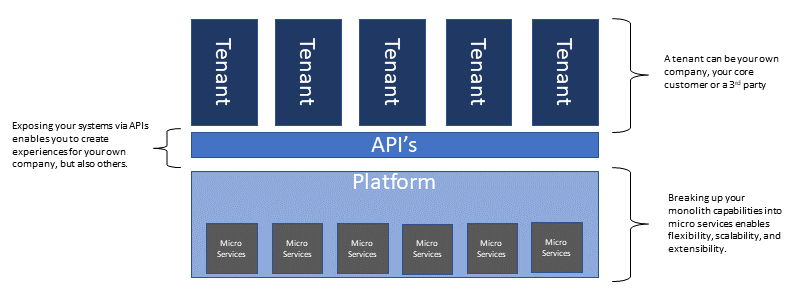Platform’s serve multiple purposes that enable the companies that build them to drive growth exponentially
I have competed against platform companies almost my whole career. I started my career in 1997, 3-years after Amazon launched. 10-years into my career, Apple iPhone launched with the App Store. 2 years into my career, Salesforce launched in 1999. I had just started a sales role and remember signing up for a free account to use as my customer relationship management system. As these companies grew, and the term “Platform” was coined, I had been using and competing with them for 15 years.
For the most part, I didn’t think about these companies as competitors. Until Amazon launched its price checker feature in their mobile app in and around the end of 2008, for the first time, consumers could walk into any retail store, check the price of the item on Amazon, and order with one click. A period of price match guarantees launched at retail stores. I was working at Target, and we had been using Amazon to host our e-commerce business. This was also at what I would call the beginning of Amazon’s sonic boom growth. They had just launched AWS two years before, monetizing the same infrastructure that powered their e-commerce sites.
Let’s pause right here. Think about that for a minute. What would happen at your company if the investments you made in everything that made you run could be monetized? The additional cash that was produced was immediately reinvested to make what made you run even better. Then with each improvement, you not only got to use it yourself but earn the investment back immediately by selling to everyone else. This is the power of the platform.
While many people focus on Amazon’s AWS cloud computing platform, their more powerful platform is the 3rd Party Seller marketplace that uses all the same tools that Amazon uses to merchandise and sell their products on Amazon.com. This marketplace allows Amazon to charge 3rd Party sellers of goods fees for listing products, warehousing and shipping products, and advertising fees. Amazon then gets a massive lift in product assortment availability without having to source and hold inventory. They get to charge others to house their inventory.
Apple and Salesforce are have created great platforms through their respective App Stores. Apple takes a 30% share of all sales of apps in their store. Salesforce gets others to extend its core product, but building extensions to full products available on their AppExchange. Salesforce makes money by licensing their core platform, force.com, and fees to perform security reviews of each available app.
Most companies would never make available what they think makes them run. In many cases, they couldn’t manage the dual tasks of running their business while servicing the customers that purchased what made the company run for their use. There is a paradigm shift that can help companies make the turn. That is to treat yourself as the very first customer of your service. Shifting to a customer mindset, you will start to think about the features you would want from the service to maximize its value. Most likely, you would like it to be low cost, for a price to be transparent, to be able to self-serve your needs as much as possible, not to be tied to a contract, and to have excellent customer service when you needed it. For those that know AWS, it sounds a lot like how it works, doesn’t it?
Platform companies bring together buyers and sellers and manage their interactions
By being your first customer, you structure your product and/or service in a manner that streamlines how it operates — minimizing the distractions of your customers to running your core business. The hardest part of becoming a platform company is the cultural change required to make it happen. There are a few critical cultural changes that companies have to lean into:
Customer Centricity
Many companies are not putting their customers at the center of everything they do or every decision they make. More than ever, customers have a choice, and the friction of shifting is significantly lowered. Companies need to ensure every employee at every level is thinking about the customer. How they buy, their needs, why they are dissatisfied, or who else they are doing business with? Simple things, such as putting pictures up of your customer in the office, on a virtual background, or in your presentation templates, can go a long way to kick start this shift.
Localized Decision Making
Traditional companies tend to collapse decision making at the highest levels of management. Platform companies have embraced the agile mindset and pushed decisions as close to the front line as possible. Similar to Lean Process Management practices introduced by Toyota in the 80’s, those on the front lines can see the friction customers have to go through first and foremost. Empowering them to make decisions that benefit the customer will accelerate the shift towards a platform mindset.
The mindset shift from cost savings towards monetization
For decades, companies look at operations to reduce costs. Platform companies look at how they can monetize operations. Can I use my call center to serve other customers? Can I warehouse products for others? Can I use my sales channels for other products and services? The revenues generated by monetizing Amazon’s operations effectively makes it free for Amazon to operate its storefront. Apple funds R&D on its hardware and operating system from payments on its App Store. Cost optimization is always important, but flipping the script and thinking about how it can be monetized could open up new opportunities for your company.
What would happen at your company if the investments you made in everything that made you run could be monetized?
Getting back to the basics of a platform company, we talked about how these companies monetize their operations. There are a few other vital aspects that make up a platform company.
Create a marketplace
From a business model perspective, platform companies bring together buyers and sellers and manage their interactions. Amazon brings customers to their 3rd party platform sellers. Apple brings App Producers to the consumers of their hardware. Airbnb brings rental owners together with guests and then sells additional services such as experiences.
APIs & Micro Services
Beyond the business model, companies need to rethink their technology stack from monolithic, closed systems to loosely coupled systems built around APIs and micro services. Stripe has built its platform based on APIs, enabling companies to embed payment capabilities into software. Enabling your APIs to be readily accessible to your customers or partners makes it even easier to extend your platform. Here you can see how Stripe caters to developers.

Engineering vs. IT
Traditional companies need to rethink their approach to technology. IT Departments are used to implementing package software, managing data centers and desktop computing, squeezing vendors, and optimizing costs. To turn your company into a platform, you will need to transform your technology organization into an engineering organization. This shift will include learning how to build software, embrace open-source frameworks and the API economy. Capital funding will need to shift from projects to products. Infrastructure will change from managing racks of servers to embracing the cloud and turning infrastructure into code.
I believe that Tesla has created an ultimate platform, in the battery and software technology it has created to run not only Tesla, by SpaceX, and its solar company. The car itself is just the window dressing on the battery and software platform. Being able to take advances in self direct flight and autonomous driving has given Tesla the competitive gap it needs to win. It’s moved into transportation with its trucking division, and will disrupt Uber with autonomous, driver less vehicles.
Not every company will evolve into a pure platform company, and they will survive. Many companies will become hybrids, where aspects of their business may be a platform, and other elements will be traditional. Target uses its stores as a platform, where other companies operate parts of its offering — Starbucks for coffee, CVS for pharmacy. It also uses its store as warehouses for home delivery via Shipt. However, it hasn’t opened up its warehousing and distribution capabilities to 3rd party resellers as Amazon has.
Even if you don’t decide to monetize your platform separate from your core business, by migrating to a platform company, you will enable innovation to happen at the speed of the market. Going through the transformation to a platform company will require your employees, technology, and leaders to embrace new ways of thinking that will make it more competitive in the digital economy we are all living in now.
Other Resources
- Platform strategy, explained | MIT Sloan
- The platform play: How to operate like a tech company (mckinsey.com)
- Platforms vs Verticals and the Next Great Unbundling — Andreessen Horowitz (a16z.com)
- Once They Were Companies, Now They Are Platform Businesses (forbes.com)
- The Platform Economy. Seven of the 10 most valuable companies… | by Jennifer L. Schenker | The Innovator news
If you enjoyed this article, stay in touch by signing up for my newsletter, day one.

